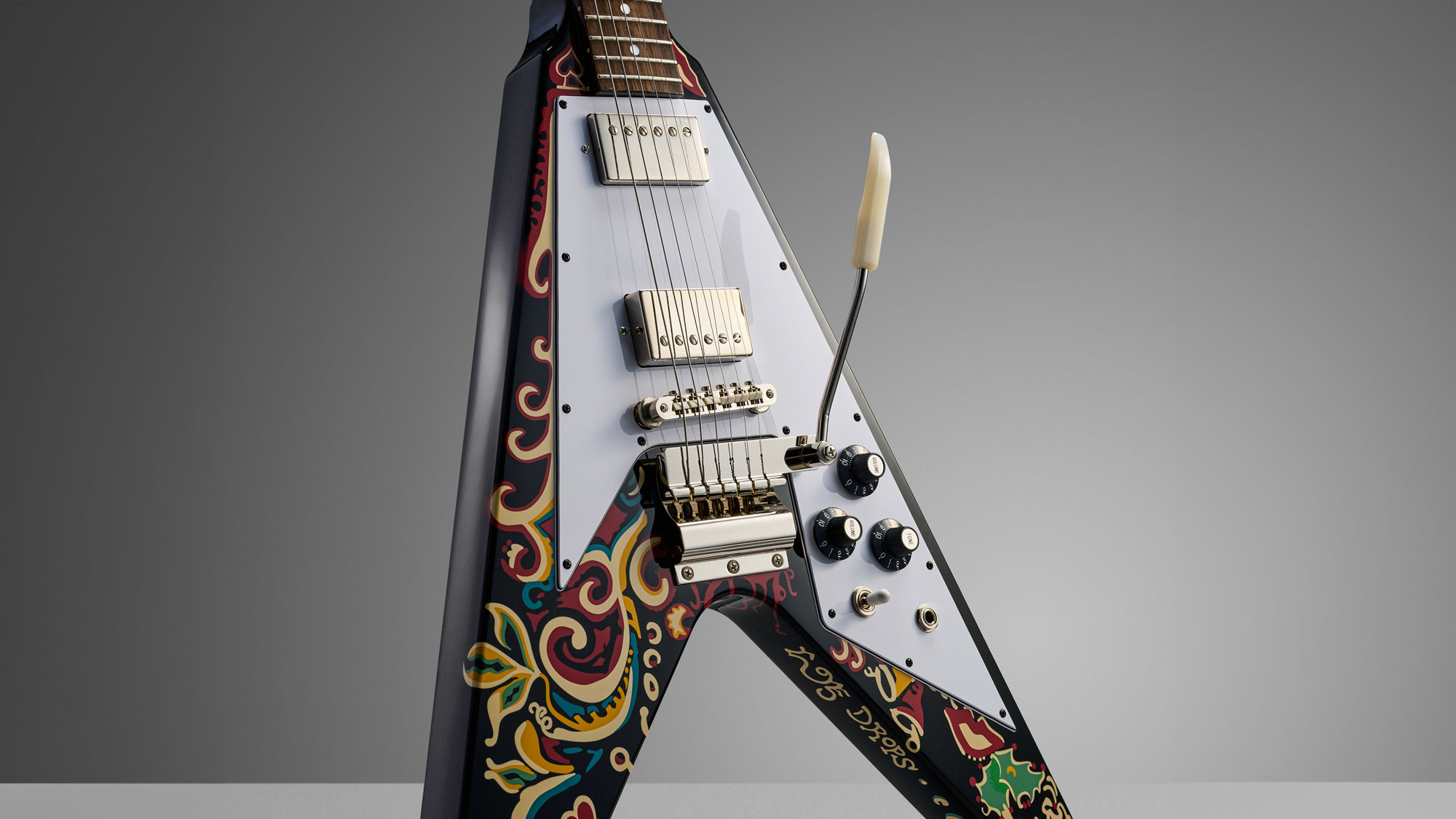
Think of Jimi Hendrix’s guitars and there are two models that are likely to spring to mind. The first would be the upside-down double-cut made by a brand starting with ‘F’ which, let’s be honest, is and always will be the go-to for aping the bulk of Jimi’s recorded tones. But then there’s the alternative: a Gibson Flying V.
Jimi was sort of late to the party with Gibson’s futuristic model, which first launched in 1958 as part of Ted McCarty’s masterplan to renew the perception of Gibson as the forward-thinking, innovative guitar brand.
But it would be another decade or so before the late-’50s idea of how the future might look would converge with the man who showed us exactly how the future of the electric guitar would sound. Jimi got his Flying V in 1967, which was a then-new model. Gibson gave the V a push, with a revamped mahogany body (vs the original korina-bodied models), a smaller headstock and tweaked control layout.
Jimi’s original started life with a sunburst finish before he sprayed it black and hand-painted the ‘Love Drops’ design himself. That brings us neatly to the guitar we have on test here – the Epiphone Inspired By Gibson Custom Jimi Hendrix Love Drops Flying V. But that only takes us partway through the story.
As we’ve seen in recent years from signature models for the likes of Joe Bonamassa, Adam Jones, Noel Gallagher and Dave Grohl to name a few, Epiphone is taking things more seriously than ever when it comes to the guitars you see in stores.
These aren’t just the ‘one you get if you can’t afford the Gibson’ models. So, in keeping with this ethos, this guitar falls into the Inspired By… collection. That means greater detail, upgraded electronics and (hopefully) an all-round better guitar brought even closer to the Gibson blueprint.
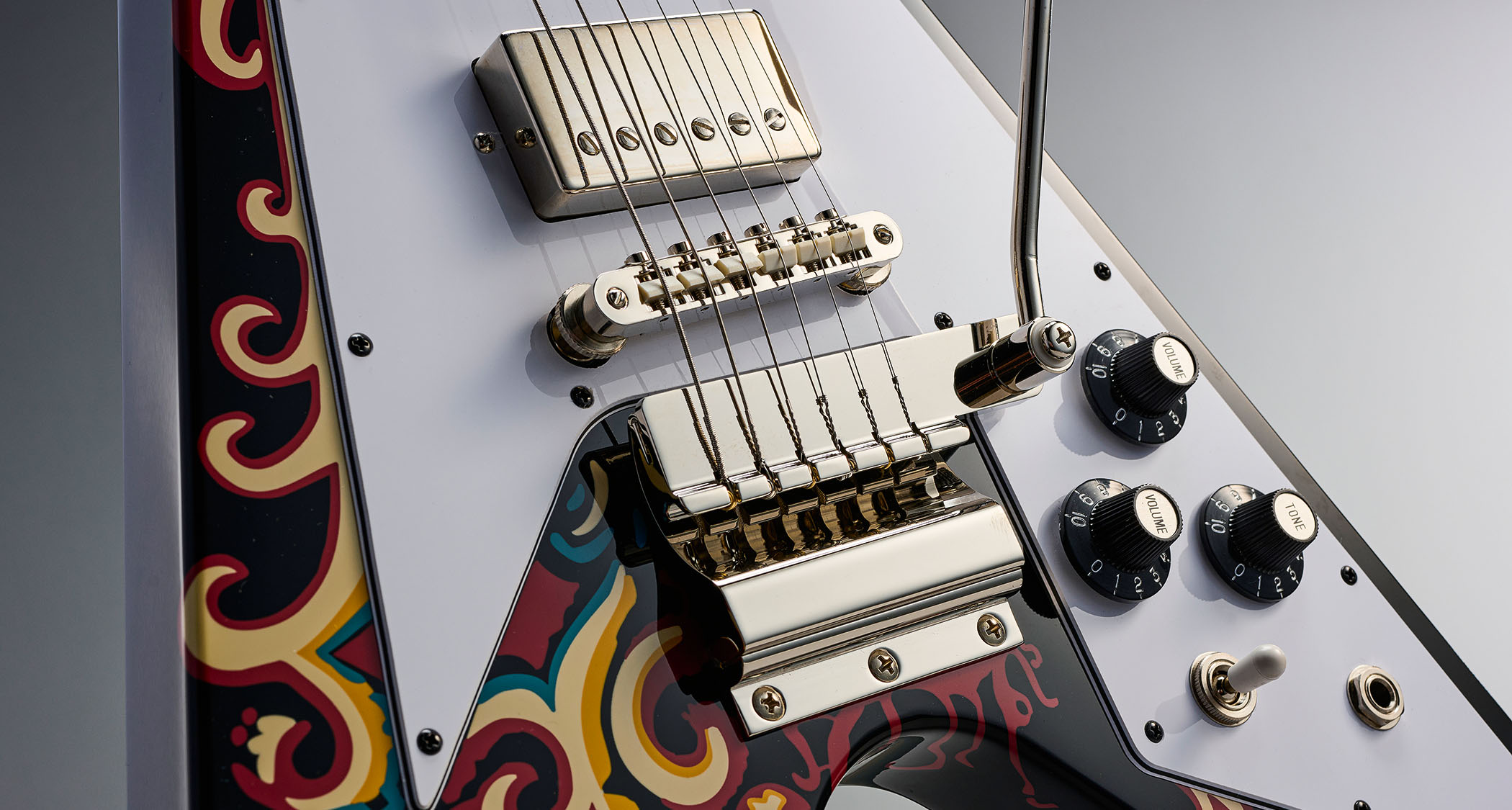
In the case of the Epiphone Love Drops, that manifests with Gibson USA Custombucker humbuckers, third-party components from CTS (pots), Mallory (capacitor in the tone circuit) and Switchcraft (the selector switch and output jack).
The body and neck are faithful to the ’67 spec, too, with the period-correct headstock, mahogany body and one-piece mahogany neck, and Epiphone has included a Maestro Vibrola vibrato as well.
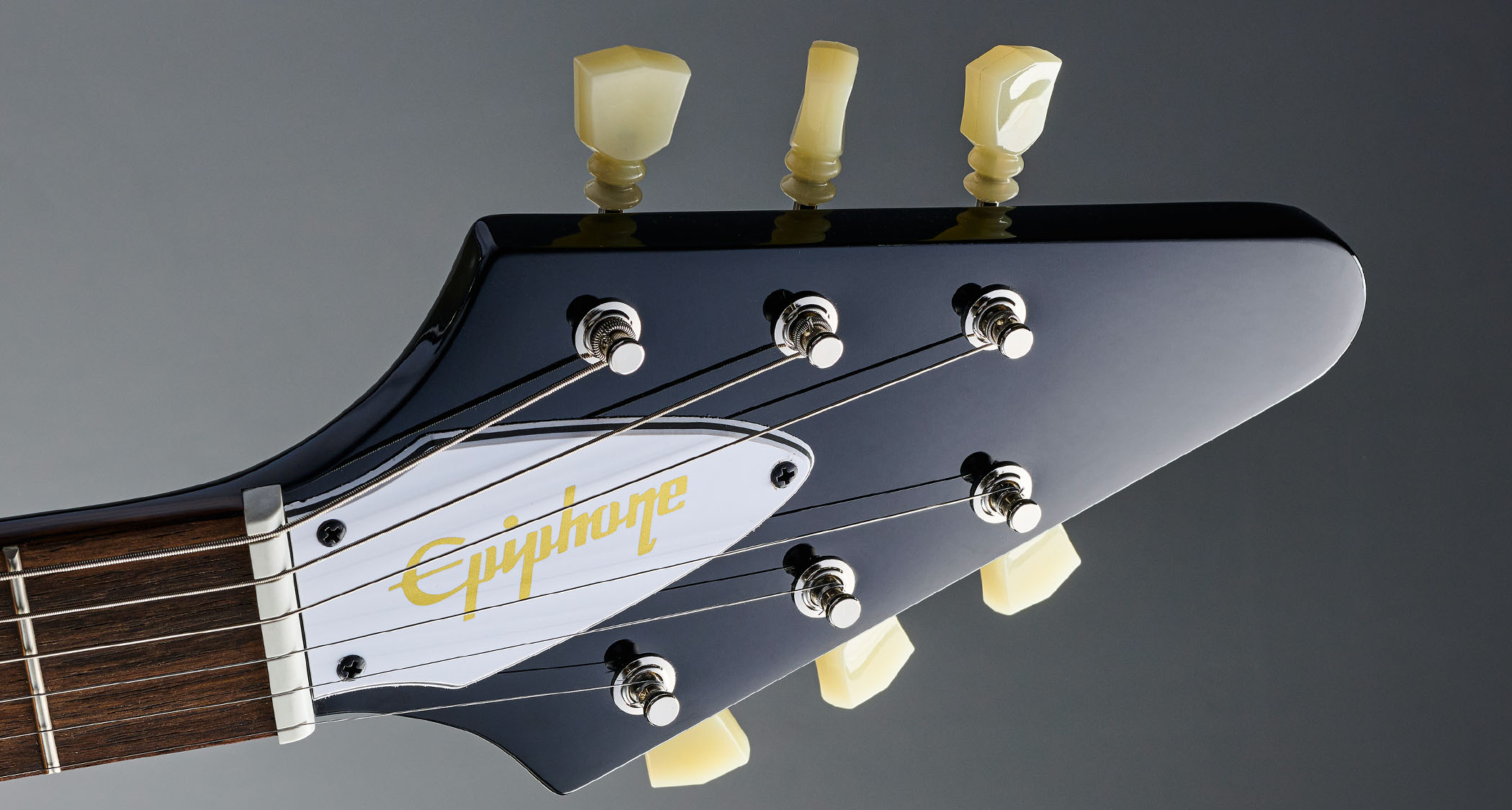
The whole lot comes packaged in a hardcase – just as well, given that a Flying V isn’t going to begin to fit in that spare generic gigbag you’ve got knocking about. The artwork is nicely done, and if you’re anything like us, you’ll spend a good while soaking up the detail. But with that, it’s time to plug in, and, of course, strap it up.
You didn’t think you were going to play this guitar seated, did you? Unlike some Flying V models, the ‘Love Drops’ doesn’t include a rubber leg grip. There’s no question: Flying Vs are made to be played standing, lest you adopt a near-vertical, neoclassical seated stance, and even then, you’ll need to be careful not to damage the points of those precarious wings against things.
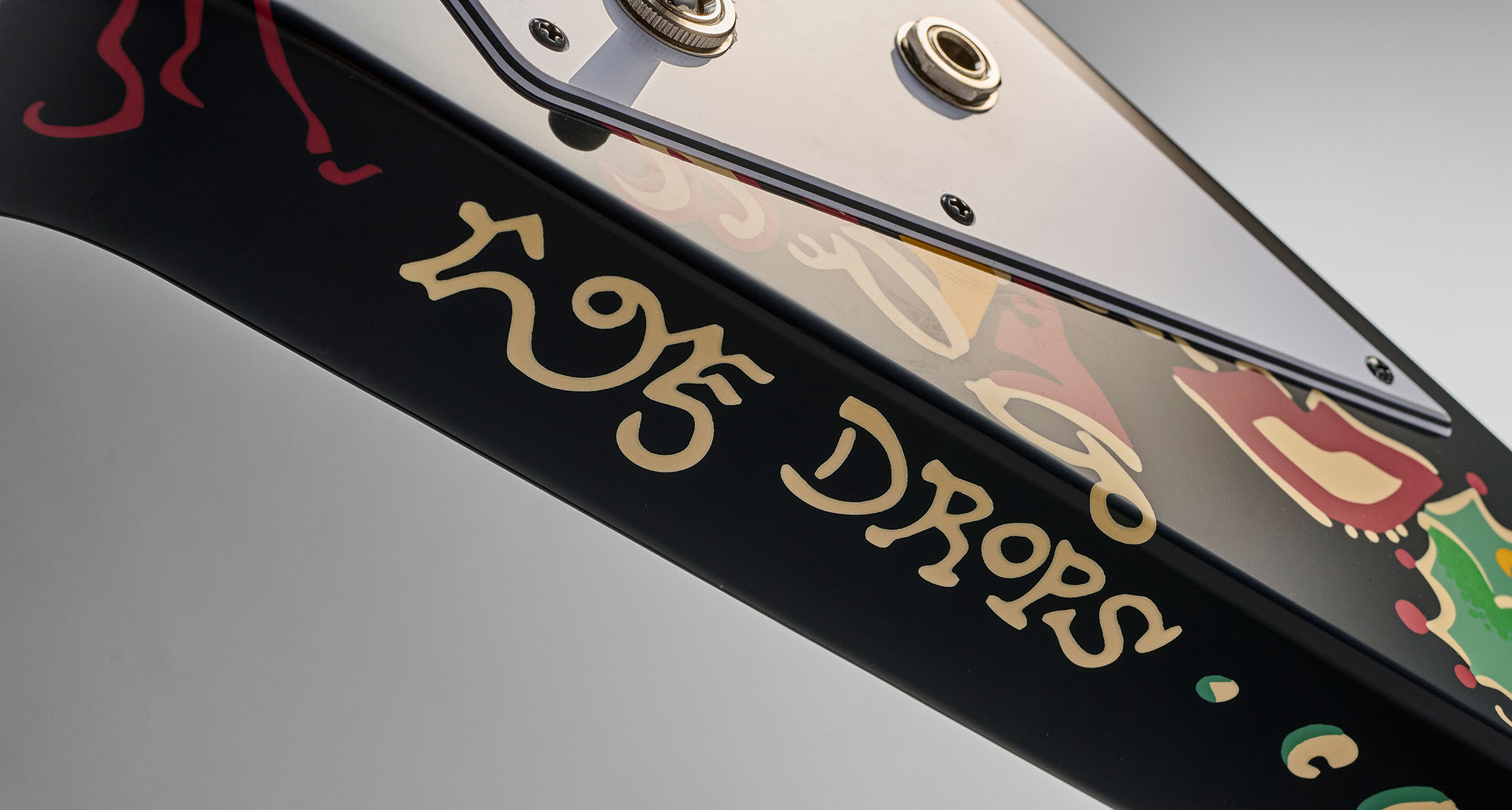
While Epiphone has recreated the Love Drops, the original guitar was very nearly lost to time. The story (as told to Chronicle Live) goes like this. Hendrix gave his V – artwork and all – to Mick Cox, guitarist of Irish rockers Eire Apparent.
Cox stripped it of Jimi’s painting, leaving it as an ebony V. Years later, UK guitarist Dave Brewis (Prefab Sprout) happened upon a left-handed Flying V in an unnamed Newcastle guitar shop. After being informed by the owner that he believed it to have belonged to Hendrix, Brewis ID’d the guitar from books and purchased it.
He later had it verified by Sotheby’s, and after painstakingly recreating the original artwork from life-size photos, confirmed with Noel Redding that the Love Drops was indeed the guitar played by Hendrix on the recording of All Along The Watchtower. The original is now owned by a US-based private collector and has been displayed at the New York Metropolitan Museum.
But, with that caveat out of the way, we can get to the actual playing. Epiphone calls the neck profile on this guitar a C-shape; in reality, it feels a little slimmer – not dissimilar to that found on our Epiphone Explorer. It’s comfortable, but not too slim, and as you’d probably expect, a fairly all-round feel.
The neck pickup is immediately impressive, with a chunky low-end and plenty of presence to offset potential wool. It’s versatile, too, sounding great clean, and handling heavier gain and fuzz nicely, and we found it lent itself nicely to drop D tuning.
Our favourite tones, though, were found with a moderate amount of crunchy overdrive. Here, we found there was a nice balance of the slightly scoop-y, low/high frequency contrast that allowed our rhythm sound to remain clear and present, while Jimi-style single-note runs bite through.
The bridge pickup also sounded great, but we found our review model to have its pickup set a little too high, in addition to a small amount of choking further up the neck on bigger bends. These are only minor maintenance tweaks, though.
The Maestro holds up well under gentle use, but if you plan on a psychedelic whammy bar freakout, be prepared to tune up again before your next song.
Overall, the Love Drops is a great statement guitar. It looks fantastic, plays well and sounds superb, particularly in the neck position.
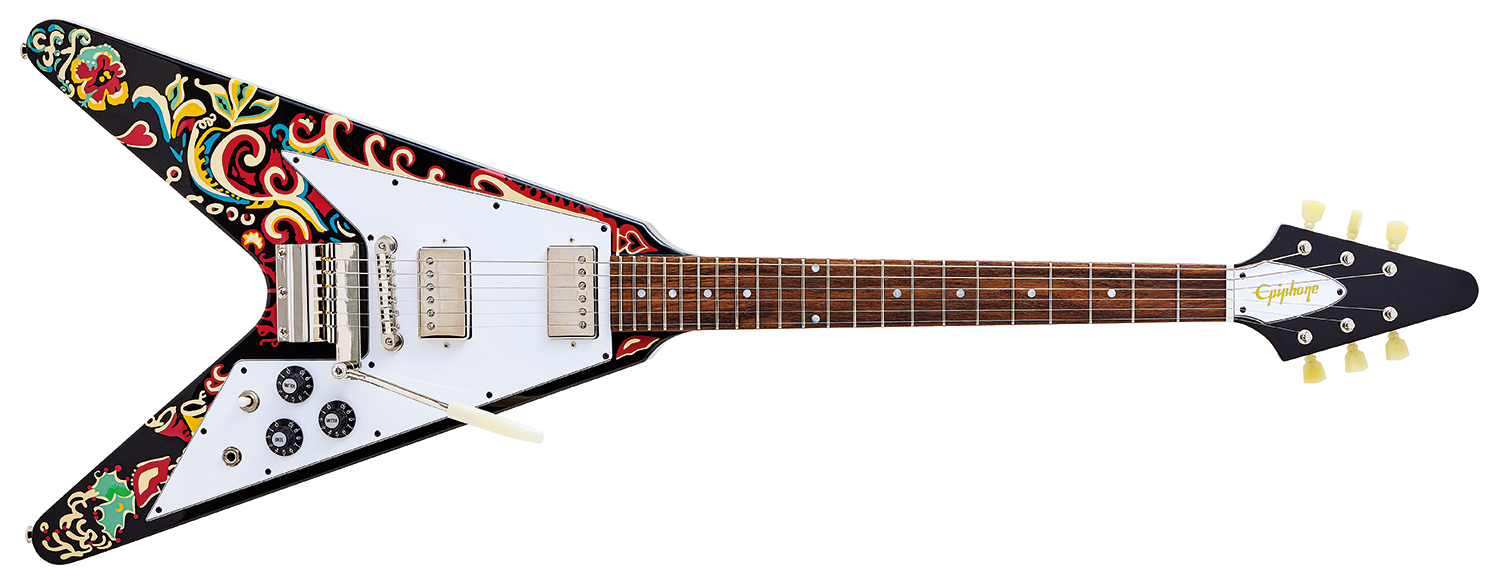
Specs
- PRICE: $/£1,499
- BODY: Mahogany
- NECK: Mahogany, one-piece
- FINGERBOARD: Laurel
- FRETS: 22, medium jumbo
- PICKUPS: Gibson Custombuckers
- CONTROLS: Volume (x2), Tone, 3-way switch
- HARDWARE: Chrome – Maestro Vibrola, LocktTone Tune-O-Matic, Epiphone Deluxe tuners
- LEFT-HANDED OPTION: Yes
- FINISH: Ebony w/ Love Drops design
- CASE: Yes
- CONTACT: Epiphone







